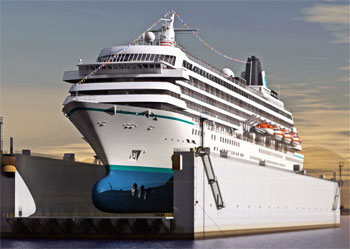Vigor Industrial has signed a contract with a Chinese shipyard to build what will be the largest floating dry dock in the United States.
The dry dock, to be stationed at Vigor’s Swan Island shipyard in Portland, Ore., will be 960 feet long with an inside width of 186 feet and a lifting capacity of 80,000 long tons. It will be 300 feet longer than Vigor’s largest current dry dock and will be able to lift triple the weight.
“We decided now is the time to buy because demand to service large vessels is growing and large dry dock capacity in proximity to the West Coast has diminished,” said Frank Foti, Vigor’s CEO, in a press release. Over the past decade a half-dozen large dry docks on the West Coast have stopped operating. Vigor is buying the new $40 million dry dock from Daoda Marine Heavy Industry Co., based in Jiangsu Province, China.
The expected delivery date is March 2014. The dry dock will be built in three pieces, which will be towed from China to the Swan Island Shipyard, where it will be assembled.
The company hopes the new dry dock will keep work in the United States. “Some of the ships that we are going to be competing on currently go overseas,” said Rene Doiron, Vigor’s vice president for ship repair.
“This will give those vessel owners another alternative,” he said.
When the dry dock is put together, Vigor will be able to work on larger vessels that the company could not service before. “With this new dock, there is virtually no vessel in the West Coast that we won’t be able to dry dock,” said Doiron.
The company has not scheduled any vessels for the new dry dock, Doiron said, although it has begun to reach out to potential clients.
The cruise ship industry is one market Vigor hopes to attract. The company will be able to work on any cruise ship, with the exception of the new 225,000-ton mega cruise ships.
Vigor will also be able to work on oil tankers that transport oil from Valdez, Alaska, to the West Coast. These are tankers up to 950 feet long, such as the Alaska class operated by Alaska Tanker Co., based in Beaverton, Ore., said Doiron.
Large ro-ro ships are another type of vessel that the new dry dock will give Vigor the ability to service. An example, Doiron said, is the 839-foot Orca-Class vessels operated by Tote Inc.
Vigor will be able to service the newest dry cargo/ammunition ship operated by the U.S. Navy’s Military Sealift Command. This is the T-AKE Class, which will replace the Kilauea-class ammunition ships and the Mars-class combat storage ships. The T-AKE Class vessel is 689 feet long with a beam of 106 feet and a displacement of 40,539 long tons.
By increasing Vigor’s dry dock capacity, the company will be able to do more work for oil and gas exploration in the Arctic. Last year, 15 percent of Vigor’s revenue came from this sector. “This is a new market that is still developing as a result of the outer shelf exploring and drilling,” Doiron said. There are no large ships in this sector that would need the new dry dock. However, it will give Vigor more flexibility in handling Arctic oil vessels.
On Feb. 27, Royal Dutch Shell announced it would suspend its operations off the north coast of Alaska and would not return in 2013. The drillship Noble Discoverer dragged anchor last July and almost grounded. The Coast Guard reported the ship had 16 safety and pollution control violations. The drillship Kulluk went aground near Kodiak Island in early January after it separated from its towing vessel during a storm with 61-knot winds and up to 40-foot seas.
Shell has spent $4.5 billion on the Arctic effort. The company planned to drill up to 10 wells in 2012, but only started two. Shell said it does plan to resume operations eventually in the Arctic.

